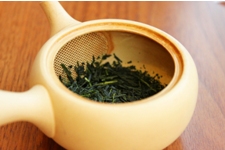How to Enjoy Japanese Tea
- Published 2010.7.13
Focusing on the pot

Focusing not only the tea itself but also on the pot it is made in allows one to further step into the world of Japanese tea. Choosing a thicker pot for piping hot tea or using a flower print pot for Kocha allows one to enjoy their tea after they`ve finished drinking it.
It is also important to have a selection of different sizes. The amount of water used in making tea determines the taste. For example, green tea (sencha) needs approximately 350 ml of water, with roasted green tea (houjicha) needing slightly more, whereas вАЭrefined green teaвАЭ (gyokuro) and other high-class teas taste best when a smaller pot is used.
Full course вАЬteaвАЭ meal

In recent times, not only has full course cuisine become popular in Japan, but also in Europe and the Americas. This full course cuisine which focuses on tea as its main dish is originally not meant to give you a full stomach, which is why it largely consists of simple foods with basic seasoning.
At a full course вАЬteaвАЭ meal, 2 different types of tea will be served. After eating, and once the Japanese sweets are brought out, a strong Japanese tea with be served. This tea is meant to be passed around and drunk by everyone. The next tea which is served is a weaker tea which is brought to each person separately.
Full course вАЬteaвАЭ course consists of:
- Rice, soup, and a small dish
- A boiled food dish
- A baked food dish
- Another small dish (ie. Salad)
- Another soup
- Finger food (ingredients grown from mountain and sea)
- Yutou and a pickled dish (Yutou is a rice dish with a light salty taste)
- Japanese sweets
- Japanese tea

